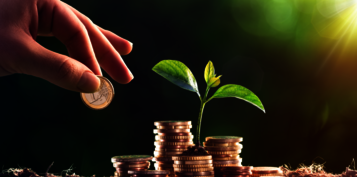Environmental markets and renewable energy
How are managers approaching climate change and where are they findings opportunities?

With the recent Extinction Rebellion protests, concerns about climate change and sustainability continue to grow. ESG (environmental, social and governance) investment has been one of the biggest investment trends in recent years. 2019 has been a record-breaking year for fund raising for the Renewable Energy Infrastructure sector with £1.06bn of new money raised (IPOs and secondary issuance from existing companies) demonstrating strong investor demand. This figure includes the new launch, Aquilla European Renewables Income, which is due to list on 5th June.
At a media roundtable held today by the Association of Investment Companies (AIC), Jon Forster, manager of Impax Environmental Markets, Richard Crawford, manager of The Renewables Infrastructure Group (TRIG) and Ben Guest, manager of Gresham House Energy Storage, discussed environmental markets, renewable energy and how they approach these themes in their portfolios.
Their thoughts have been collated alongside comments from Chris Tanner, director of John Laing Environmental Assets Group (JLEN).
Where are you investing recently?
Jon Forster, manager of Impax Environmental Markets, said: “We invest in four sectors; new energy, water, waste and sustainable food and agriculture. We look for companies providing compelling solutions to environmental challenges. For example, investing in companies offering products and services that help us to either adapt to or mitigate climate change.
“The main objective of our portfolio is to deliver strong risk-adjusted returns for our investors. However, as an outcome of the opportunities that we actively invest in, the portfolio delivers a net environmental benefit. Of the technologies in our universe, those that have the biggest net environmental impact are reverse vending machines and renewable energy.”
Richard Crawford, manager of The Renewables Infrastructure Group (TRIG), said: “To date TRIG has invested in wind, solar and battery storage. Jädraås wind farm is an example of one of our more recent acquisitions. This is a large operational onshore wind farm in Sweden, capacity 213MW (megawatts), which we acquired in February. Jädraås is interesting because most of the revenues come from power sales rather than a subsidy, which demonstrates the success of renewables as costs have been coming down. In 2018, TRIG acquired several assets with highly contracted feed-in-tariff or contract-for-difference subsidy revenues, so Jädraås complements our existing portfolio nicely.”
Chris Tanner, director of John Laing Environmental Assets Group (JLEN), said: “JLEN has invested in a diversified portfolio of environmental infrastructure projects across a range of technologies, including onshore wind, solar photovoltaic, wastewater and waste management, and anaerobic digestion. We have recently been acquiring assets in the anaerobic digestion sector, such as Vulcan Renewables, a 5MWth (megawatt thermal) plant that uses energy crops as a feedstock and produces ‘green’ gas (gas created from biodegradable material that can displace fossil fuel gas) for the UK’s gas network, for which it earns an attractive inflation-linked subsidy. We are engaged in an upgrade project at Vulcan that will more than double its capacity, generating enhanced returns for investors.”
Ben Guest, manager of Gresham House Energy Storage, said: “The Gresham House Energy Storage Fund seeks to capitalise on the growing intraday supply and demand imbalances caused by our increasing reliance on renewable energy. The fund is aiming to provide investors with an attractive and sustainable dividend by investing in a portfolio of grid-connected, utility-scale energy storage systems located in Great Britain, which primarily use batteries to import and export power, accessing multiple revenue sources available in the power market.
“After the fund’s successful £100m IPO in November 2018, a portfolio of five operational seed energy storage systems projects was acquired, with a total capacity of 70MW. Of these, Project Staunch in Staffordshire and Project Roundponds in Wiltshire are the two largest at 20MW each. These two projects are typical of the fund’s investments. Set within a reasonably small compound of 1-2 acres, lithium-ion batteries function as the core component of the projects which store and release power almost immediately upon receiving the signal to do so.”
Public concern
Richard Crawford, manager of The Renewables Infrastructure Group (TRIG), said: “Recent climate change activism highlights the increasing public awareness of environmental issues. Whilst we do notice more shareholders prioritising sustainability, much of TRIG’s success to date has been based on its track record of achieving investor returns, which for us is intrinsically linked to its sustainable business model. Ultimately the positive outlook for the sector is supported by the long-term fundamentals behind the need to transition to a low-carbon future.”
Ben Guest, manager of Gresham House Energy Storage, said: “Energy generation in the UK is undergoing fundamental change. Older coal and gas-fired stations are being decommissioned and renewable energy is increasing its share of the energy mix. The growing public concern about the impact of power generation from fossil fuels on the health of the planet is certainly a key driver of this change. Demonstrations such as those organised by the Extinction Rebellion movement have demonstrated how passionately some sections of the public feel about the transition to renewable energy power generation and a low carbon economy. We are determined to be a part of the energy generation revolution and support the shift from finite resources to a clean energy world.”
Jon Forster, manager of Impax Environmental Markets, said: “In outlook terms, the case for environmental markets has never been stronger. However, where it gets really interesting is the addition of positive disruptions, because they really accelerate growth. The science of climate change is no longer in doubt and what is clear is that, on its present trajectory, the economy cannot react quickly enough to the climate challenges we are facing. Governments will turn up the ratchet of regulation, which will in turn encourage action – we’ve seen this most recently with the war on plastic, for which the regulatory response has been unprecedented. But there is also a clear need to adapt to climate change. I have been co-managing IEM for 17 years and the growth trajectory for environmental markets really has never looked as compelling to me as it does now.”
Chris Tanner, director of John Laing Environmental Assets Group (JLEN), said: “Investors are becoming more mindful of environmental concerns when considering investments, with some investors having specific criteria governing what they can and can’t invest in. The listed renewables sector has benefited from its ‘green’ credentials and the increasingly mainstream view that renewables will be a major part of the energy mix of the future. JLEN has recently undertaken environmental impact reports on each of its assets to provide investors with additional information on the benefits that the portfolio provides to the environment.”
Impact of politics and regulation – boost or hindrance?
Chris Tanner, director of John Laing Environmental Assets Group (JLEN), said: “The general political direction is undoubtedly a tailwind – public support for more environmentally friendly infrastructure is growing and is set to become a major part of the economy, supporting jobs and providing low carbon energy. Regulation can sometimes be a headwind, for example when Ofgem makes changes to the rules surrounding the electricity network that negatively impact renewable generators.”
Jon Forster, manager of Impax Environmental Markets, said: “The myth that environmental markets rely on environmental subsidies for returns persists. The reality is that we benefit from the tightening of regulation, and it isn’t just environmental regulation. Tightening standards in recycling, water quality, building regulations, emissions, food standards – you name it, they all demand more resource efficient solutions.”
Richard Crawford, manager of The Renewables Infrastructure Group (TRIG), said: “Over the shorter term, politics and regulation can be a headwind if you are restricted to investing in certain markets. Geographic diversification and, in turn, diversification of regulatory risk remain some of the key pillars of TRIG’s strategy. We are able to invest in different markets and geographies depending on where the opportunities are. However, over the longer term, politics and regulation is a tailwind for our sector, with most governments and supranational organisations generally supportive of decarbonisation.”
Subsidy-free renewable energy as a viable investment – how long will it take?
Chris Tanner, director of John Laing Environmental Assets Group (JLEN), said: “Subsidy-free wind and solar is a viable investment now in particular circumstances, but the risk profile is different to the subsidised projects that came before. In particular, the nature of the electricity-selling arrangements can make a big difference – is the project subject entirely to movements in wholesale electricity markets, or has it been able to secure some other arrangement that insulates it, to an extent, from price risk? Unsubsidised assets are also younger than their more established subsidised cousins, and this can also increase risks associated with early-stage assets such as energy yield forecasts and performance optimisation.”
Richard Crawford, manager of The Renewables Infrastructure Group (TRIG), said: “We believe that in certain geographies for the best sites it is already viable. For wind, the scale of the plant including the size of individual turbines is important, as well as strong and consistent wind levels. The climate favours wind in the northern latitudes like Scotland and Scandinavia, whereas solar is in the sunnier south such as Spain and Italy.”
Ben Guest, manager of Gresham House Energy Storage, said: “The UK’s exposure to renewable energy generation has increased significantly over the last few years and the pace has not lessened despite the removal of legacy subsidies to onshore wind and solar. This is largely because the development of offshore wind installations has continued apace. As a result, generation from wind is having a growing impact on the grid, generating a volatile supply of energy which underpins the opportunity for energy storage systems.
“Ultimately returns from energy storage systems can be generated from multiple revenue streams, are not correlated to the absolute level of wholesale power prices and not dependent
on any subsidies, so they represent an attractive opportunity for investors.”
-Ends-
Follow us on Twitter @AICPRESS
Notes
- The Association of Investment Companies (AIC) was founded in 1932 to represent the interests of the investment trust industry – the oldest form of collective investment. Today, the AIC represents a broad range of closed-ended investment companies, incorporating investment trusts and other closed-ended investment companies and VCTs. The AIC’s members believe that the industry is best served if it is united and speaks with one voice. The AIC’s mission statement is to help members add value for shareholders over the longer term. The AIC has 359 members and the industry has total assets of approximately £191 billion.
- Disclaimer: The information contained in this press release does not constitute investment advice or personal recommendation and it is not an invitation or inducement to engage in investment activity. You should seek independent financial and, if appropriate, legal advice as to the suitability of any investment decision. Past performance is not a guide to future performance. The value of investment company shares, and the income from them, can fall as well as rise. You may not get back the full amount invested and, in some cases, nothing at all.
- To stop receiving AIC press releases, please contact the communications team.





